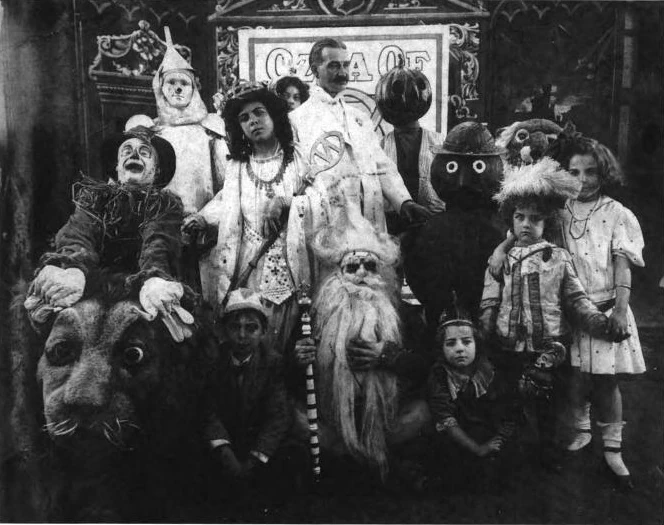In this picture, L. Frank Baum poses with actors from his Fairylogue and Radio-Plays. Always intent to expand his Oz books into a transmedia franchise, Baum, with this project, created what seems to be a rather unusual media form based on The Wonderful Wizard of Oz (1900), The Marvelous Land of Oz (1904), Ozma of Oz (1907), and one of his non-Oz fantasy books, John Dough and the Cherub.The Fairylogue and Radio-Plays combined hand-colored slide projections and moving film clips with live actors. Baum himself played the narrator in a fashion that sounds reminiscent of popular projection lectures of the nineteenth century, only here he interacted with the movies as well as the live actors. It seems like it was probably as much an advertisement for the books as an attraction in itself. The Fairylogue and Radio-Plays was expensive to produce and to tour. Although it was well-received, it lost money, and the expense sent Baum into bankruptcy. Little more exists of this production than a handful of photographs, a couple of advertisements, and an archived script. None of the slides or films survive, so we'll likely never see those. I am struck by the fact that there are a number of children in the cast, including Romola Remus as Dorothy. I would love to know more about these child actors and how they performed in the show.
Tuesday, October 2, 2018
Fairylogue and Radio-Plays
In this picture, L. Frank Baum poses with actors from his Fairylogue and Radio-Plays. Always intent to expand his Oz books into a transmedia franchise, Baum, with this project, created what seems to be a rather unusual media form based on The Wonderful Wizard of Oz (1900), The Marvelous Land of Oz (1904), Ozma of Oz (1907), and one of his non-Oz fantasy books, John Dough and the Cherub.The Fairylogue and Radio-Plays combined hand-colored slide projections and moving film clips with live actors. Baum himself played the narrator in a fashion that sounds reminiscent of popular projection lectures of the nineteenth century, only here he interacted with the movies as well as the live actors. It seems like it was probably as much an advertisement for the books as an attraction in itself. The Fairylogue and Radio-Plays was expensive to produce and to tour. Although it was well-received, it lost money, and the expense sent Baum into bankruptcy. Little more exists of this production than a handful of photographs, a couple of advertisements, and an archived script. None of the slides or films survive, so we'll likely never see those. I am struck by the fact that there are a number of children in the cast, including Romola Remus as Dorothy. I would love to know more about these child actors and how they performed in the show.
Subscribe to:
Post Comments (Atom)


No comments:
Post a Comment